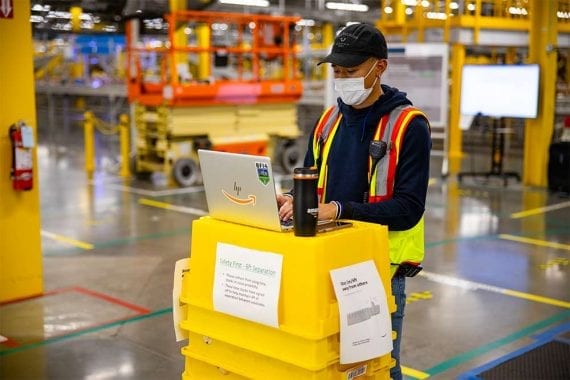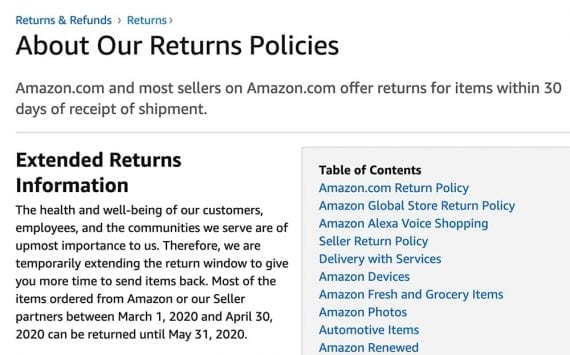The coronavirus pandemic has forced retailers large and small to make significant, temporary changes to their return practices. Since March, retailers have handled returns in two ways, generally.
First, retailers have extended return times, allowing shoppers to send back items, 60, 90, or even 180 days after purchase.
Second, retailers have temporarily suspended returns altogether until the pandemic passes.
Both of these changes will likely impact retailer profits in the next month or two.

The pandemic has altered operations, including product returns, for many ecommerce merchants. Here a worker at an Amazon fulfillment center wears a mask.
Extended Returns
Merchants have extended their return windows since the pandemic forced shut-downs and hindered shipping. This includes some of the retail industry’s largest omnichannel and pure-play ecommerce stores.
For example, before the pandemic, Amazon offered a 30-day return window on most orders. But that’s changed.
“The health and well-being of our customers, employees, and the communities we serve are of utmost importance to us,” read the return policy page on Amazon’s website on April 28, 2020. “Therefore, we are temporarily extending the return window to give you more time to send items back. Most of the items ordered from Amazon or our Seller partners between March 1, 2020, and April 30, 2020, can be returned until May 31, 2020.”

The updated return policy from Amazon states, in part, “…we are temporarily extending the return window to give you more time to send items back.”
Similarly, Macy’s announced that it would give in-store shoppers an additional 30 days to return items and ecommerce shoppers an additional 60 days.
The need to alter return policies also affects mid-sized retailers. A communications manager at BigCommerce, the ecommerce platform, offered as an example one of the company’s customers, La Perla, an apparel retailer.
“As we are all adapting to the current circumstances, we have extended our current return policy to 60 days for online orders (final sale excluded) bought after March 1st, 2020,” the La Perla website stated.
“We apologize for any inconvenience, and we thank you for your understanding and patience at this difficult time.”
Paul Magel, president of the business applications division at CGS, a learning and outsourcing firm, summed up, in an email to Practical Ecommerce, the need for extended returns.
“If retailers did not change their policy to match the times and the constraints of the pandemic, consumers would just shop elsewhere with retailers that offer more accommodating policies. In ecommerce, returns are still a cost of business. Consumers expect liberal return policies, so retailers have removed any purchase risk for consumers who are buying something they have not been able to touch or feel. This is especially true in fashion and apparel,” Magel said.
“Returns have long been a focal point of ecommerce business, as many point to that area as a major leakage of both revenue and profit. This lengthened return policy is just another variable in the new normal that brands and retailers will have to factor into their ongoing business model. This change in policy was not for improvement to customer service or goodwill; rather, it is seen as a necessity to continue to conduct business during this time of stay-at-home orders and social distancing.”
Suspended Returns
In other cases, returns have been suspended or canceled altogether — mainly due to public health. Retailers were doing their best to “flatten the curve” and limit the coronavirus’s spread. Thus, not recirculating returns made sense.
For example, Walmart has stopped accepting in-store returns or exchanges for several product categories, including food, paper goods, home cleaning supplies, laundry soap, pharmacy, health and beauty products, and apparel, according to the company’s website on April 28, 2020.

Walmart’s new return and exchange policy states, “We are temporarily not processing returns/exchanges in our stores of: food, paper goods, home cleaning supplies, laundry soap, pharmacy, healthy & beauty and apparel.”
Likewise, Target suspended returns from March 26 to April 26, 2020, in most stores nationwide. At the time of writing, it was still not accepting in-store returns in New Jersey.
Other retailers are simply making all sales final.
Profit Repercussions
However unavoidable they are, these pandemic-induced changes to return and exchange policies will likely reduce profit in the near term for some retailers.
The problems could arise in two forms.
First, there could be a glut of returns after stores reopen and after ecommerce operations come back in full force. Consider, for example, Target’s statement from a March 25, 2020, blog post.
To be extra cautious, Target will stop accepting in-store product returns and exchanges for the next three weeks—but don’t worry if you have a return that expires during that period, because we’ll still honor them three weeks past the holding period [emphasis added].
Many retailers that have suspended returns (or stated that sales are final) may feel compelled to accept very late exchanges.
Similarly, retailers that extended the windows could receive returns in May, June, and beyond.
Second, the returns that do arrive may be worth less.
“Retailers will now need to factor in the increased cost of returns, resulting from goods having been purchased at a much higher price point than what that return will be worth when it is sent or brought back to the store,” said CGS’s Magel.
The problem Magel describes is especially real for seasonal goods such as fashion apparel.
These items generally start at a peak price just before the season begins. By mid-season, retailers will begin to offer discounts. As the season ends, the items are often placed on closeout.
Imagine, for example, a spring fashion raincoat purchased in March for $199. By mid-April, its retail price may have dropped 25 percent. In July, it’s on closeout for $59.
CGS’s Magel said, “For apparel and other seasonal or non-essential goods, there is a large amount of inventory already in stores or in transit that will be out of season when stores are ready to reopen. Also, the amount of orders and volumes that have been cut from retail buying has caused huge inventories further back in the supply chain that will need to be moved; therefore, heavily discounted.”







